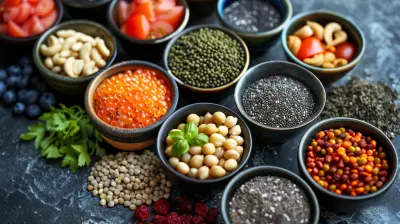How to Balance Your Omega-6 to Omega-3 Ratio for Optimal Health
10 October 2025
Let’s be honest – most of us don’t think twice about the types of fats we’re putting into our bodies. We hear “omega-3” and think fish oil. “Omega-6”? Probably not even on your radar. But here’s the kicker: the balance between these two fatty acids can make or break your health.
Yep, you read that right. It’s all about balance. Like a see-saw, the omega-6 to omega-3 ratio should stay pretty level. But for most people eating a modern Western diet, that see-saw is way off-kilter – and it’s causing all kinds of trouble.
In this article, we’re going to dive into why this ratio matters, how it gets thrown out of balance, and most importantly, what you can do to bring it back under control. You don’t need to do a complete diet overhaul. A few tweaks here and there can make a massive difference.
What Are Omega-6 and Omega-3 Fatty Acids Anyway?
Before we dive into ratios and food lists, let’s clear something up: omega-6 and omega-3 are essential fats. That means your body can’t make them on its own—you have to get them from your diet.Omega-6 Fatty Acids
Omega-6s are typically found in vegetable oils like corn, soybean, safflower, and sunflower oils. They're also in lots of processed foods (think chips, salad dressings, and fast food). They’re not the bad guys—your body actually needs them for brain function, skin and hair growth, and even hormone health.But here's the thing: too much of a good thing? Not so good anymore.
Omega-3 Fatty Acids
Omega-3s are your anti-inflammatory superheroes. They come in three main forms:- ALA (alpha-linolenic acid) – found in flaxseeds, chia seeds, and walnuts.
- EPA (eicosapentaenoic acid) – mostly in fatty fish like salmon and mackerel.
- DHA (docosahexaenoic acid) – also in fatty fish and key for brain and eye health.
While ALA is plant-based, EPA and DHA are the power players when it comes to reducing inflammation.
Why the Omega-6 to Omega-3 Ratio Matters
Now here’s where it gets interesting. Omega-6 and omega-3 fatty acids compete for the same enzymes in your body. That means if you eat too many omega-6s and not enough omega-3s, your body starts producing more inflammatory compounds and fewer anti-inflammatory ones.So, What’s the Ideal Ratio?
The ideal omega-6 to omega-3 ratio is believed to be somewhere between 1:1 and 4:1. But most Western diets? They’re sitting somewhere around 15:1 or even 20:1! That’s like having a fire hose of inflammation pouring into your body every single day.Chronic inflammation is the root of many modern diseases—think heart disease, arthritis, autoimmune issues, and even depression.
Signs Your Omega-6 to Omega-3 Ratio Might Be Out of Whack
Not sure if your fatty acid balance is off? Here are a few red flags:- You're tired all the time
- Your joints are constantly inflamed or achy
- You struggle with anxiety or depression
- Your skin is dry or breaking out
- You have high blood pressure or cholesterol
Of course, these symptoms can be caused by other issues too—but if you’re eating a lot of processed foods and rarely eating fish, it's a safe bet your ratio needs work.
Easy Ways to Improve Your Omega-6 to Omega-3 Ratio
Don’t worry—you don’t have to become a nutrition guru overnight. Small, consistent changes can go a long way. Below we’ll break down simple strategies you can start using today.1. Cut Back on Vegetable Oils
This is the biggie. Vegetable oils like corn, soybean, and sunflower oil are everywhere. Check your pantry. Check your go-to snacks. Even “healthy” frozen meals often rely on these oils.Try swapping them with healthier fats like:
- Extra virgin olive oil – great for low-heat cooking and salad dressings
- Avocado oil – has a high smoke point and a mild flavor
- Coconut oil – good for baking and sautéing
2. Say “No” to Ultra-Processed Foods
We’re not here to ruin your snack game. But if your diet is heavy on chips, frozen pizza, and store-bought cookies, you’re likely drowning in omega-6s. Try cutting back or swapping in healthier options.Instead, reach for whole foods like:
- Fresh fruits and veggies
- Whole grains
- Nuts and seeds (especially flax and chia)
- Homemade treats using better oils
3. Eat More Fatty Fish (or Try Fish Oil)
You need to bring more omega-3s to the party. Fatty fish like salmon, sardines, mackerel, and anchovies are excellent sources of EPA and DHA.Aim for two servings of fatty fish per week. Not into seafood? Consider a high-quality fish oil supplement or algae oil if you’re vegetarian.
A good daily dose of EPA/DHA from fish oil is around 250–500 mg combined for general health.
4. Go Nuts for Seeds (Literally)
Flaxseeds, chia seeds, and walnuts are packed with ALA, the plant-based version of omega-3. While ALA isn’t as powerful as EPA and DHA, it still contributes to the balance.Pro tip: Grind your flaxseeds—your body can absorb the nutrients better that way.
5. Eat Grass-Fed or Pasture-Raised Meats
Did you know cows that eat grass have a better omega-6 to omega-3 ratio than grain-fed cows? The same goes for eggs—pasture-raised eggs contain more omega-3s.It might cost a bit more, but it’s a simple switch that can help balance your fats.
6. Supplement Wisely
If you’re not getting enough omega-3s through food, supplements can really help. Look for:- Fish oil or krill oil – rich in EPA and DHA
- Algae oil – great plant-based option
- Flaxseed oil – for boosting ALA intake
Just make sure to talk to your doctor before starting any supplement routine, especially if you’re on medication.
Sneaky Sources of Omega-6 You Might Be Missing
Here are a few places omega-6s hide out:- Store-bought salad dressings
- Mayonnaise
- Granola bars
- Roasted nuts (in vegetable oil)
- Restaurant food (especially fried dishes)
Read labels carefully and make swaps when you can. Even choosing raw nuts over roasted ones can make a difference.
Creating a More Balanced Plate: What to Eat in a Day
Need a visual? Here’s how a day of meals might look when you're aiming to balance your omega-6 to omega-3 ratio.Breakfast
- Overnight oats with chia seeds, walnuts, and a drizzle of honey
- Green tea or black coffee
Lunch
- Grilled salmon salad with olive oil and lemon dressing
- Whole grain bread or a side of quinoa
- Fresh fruit like berries or an apple
Snack
- Greek yogurt with ground flaxseed
- A handful of raw almonds
Dinner
- Grass-fed beef or lentil stew with sweet potatoes
- Steamed broccoli with a touch of olive oil
- Optional: omega-3 supplement after the meal
This kind of plan keeps you full, energized, and inflammation in check—without sacrificing flavor.
Be Patient—Balance Takes Time
Changing your omega-6 to omega-3 ratio isn’t something that happens overnight. Your cells literally need time to rebuild with the right fats. Think of it as changing the oil in your car—it doesn’t fix everything right away, but it makes your engine (aka your body) run a whole lot smoother over time.Stick with it. Small changes each week can lead to big gains in a couple of months. Better energy, clearer thinking, healthier skin, and even a boosted mood—that’s your body thanking you for giving it what it really needs.
Final Thoughts
Balancing your omega-6 to omega-3 ratio doesn’t mean turning your life upside-down. It’s about making smarter food choices, being mindful of hidden oils, and adding in more omega-3-rich foods.So take that first step. Swap out that cooking oil. Add some chia seeds to your morning smoothie. Pick salmon over steak tonight. Your body will feel the difference—and future you will be grateful.
The goal here isn’t perfection—it’s progress.
all images in this post were generated using AI tools
Category:
Healthy FatsAuthor:

Sophia Wyatt
Discussion
rate this article
1 comments
Selkie Baxter
Prioritize Omega-3; your health demands it!
October 19, 2025 at 4:35 AM

Sophia Wyatt
Absolutely! Balancing omega-3 and omega-6 is crucial for health, and prioritizing omega-3 can help achieve that balance.


